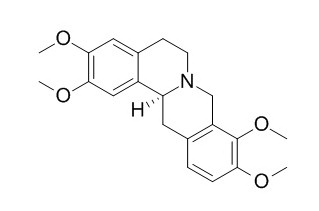D-Tetrahydropalmatine
D-Tetrahydropalmatine is a organic cation transporter 1 (OCT1) inhibitor, it can obviously inhibit the uptake of monocrotaline (MCT) in MDCK-hOCT1 cells and isolate rat primary hepatocytes, and attenuate the viability reduction and LDH release of the primary cultured rat hepatocytes caused by MCT.
Inquire / Order:
manager@chemfaces.com
Technical Inquiries:
service@chemfaces.com
Tel:
+86-27-84237783
Fax:
+86-27-84254680
Address:
1 Building, No. 83, CheCheng Rd., Wuhan Economic and Technological Development Zone, Wuhan, Hubei 430056, PRC
Providing storage is as stated on the product vial and the vial is kept tightly sealed, the product can be stored for up to
24 months(2-8C).
Wherever possible, you should prepare and use solutions on the same day. However, if you need to make up stock solutions in advance, we recommend that you store the solution as aliquots in tightly sealed vials at -20C. Generally, these will be useable for up to two weeks. Before use, and prior to opening the vial we recommend that you allow your product to equilibrate to room temperature for at least 1 hour.
Need more advice on solubility, usage and handling? Please email to: service@chemfaces.com
The packaging of the product may have turned upside down during transportation, resulting in the natural compounds adhering to the neck or cap of the vial. take the vial out of its packaging and gently shake to let the compounds fall to the bottom of the vial. for liquid products, centrifuge at 200-500 RPM to gather the liquid at the bottom of the vial. try to avoid loss or contamination during handling.
Food and Fermentation Industries2019, 45(7):45-51
Biocell2023, 47(8):1793-1802
Microorganisms.2021, 9(12):2514.
J Ethnopharmacol.2020, 269:113752.
Nutr Res Pract.2023, 17(4):670-681.
Tumour Biol.2015, 36(9):7027-34
ScienceAsia2024, 50,2024073:1-9
Neurochem Int.2020, 133:104629
Nutrients.2023, 15(4):954.
bioRxiv - Biochemistry2023, 541790.
Related and Featured Products
Toxicology. 2013 Sep 15;311(3):225-30.
Organic cation transporter 1 mediates the uptake of monocrotaline and plays an important role in its hepatotoxicity.[Pubmed:
23831208]
Monocrotaline (MCT) is a kind of toxic retronecine-type pyrrolizidine alkaloids (PAs) from plants of Crotalaria, which can be bio-activated by cytochrome P450 (CYP) enzymes in liver and then induce hepatotoxicity. Since CYPs are localized in the endoplasmic reticulum, the influx of MCT to the liver is the key step for its hepatotoxicity.
METHODS AND RESULTS:
The objective of the present study was to investigate the role of organic cation transporter 1 (OCT1), a transporter mainly expressed in liver, in the uptake of MCT and in hepatotoxicity induced by MCT. The results revealed that MCT markedly inhibited the uptake of 1-methyl-4-phenylpyridinium (MPP(+)), an OCT1 substrate, in Madin-Darby canine kidney (MDCK) cells stably expressing human OCT1 (MDCK-hOCT1) with the IC50 of 5.52±0.56μM. The uptake of MCT was significantly higher in MDCK-hOCT1 cells than in MDCK-mock cells, and MCT uptake in MDCK-hOCT1 cells followed Michaelis-Menten kinetics with the Km and Vmax values of 25.0±6.7μM and 266±64pmol/mg protein/min, respectively. Moreover, the OCT1 inhibitors, such as quinidine, D-Tetrahydropalmatine (d-THP), obviously inhibited the uptake of MCT in MDCK-hOCT1 cells and isolated rat primary hepatocytes, and attenuated the viability reduction and LDH release of the primary cultured rat hepatocytes caused by MCT.
CONCLUSIONS:
In conclusion, OCT1 mediates the hepatic uptake of MCT and may play an important role in MCT induced-hepatotoxicity.
hongguo Yao Li Xue Bao. 1989 Mar;10(2):104-10.
Effects of tetrahydroprotoberberines on dopamine receptor subtypes in brain.[Pubmed:
2530755]
The effects of 12 tetrahydroprotoberberines (THPBs) on D1 and D2 receptors labelled with [3H]DA, [3H]Sch-23390 and [3H]spiperone were evaluated. Their effects on the activity of adenylate cyclase stimulated with DA 40 mumols/L were also assessed.
METHODS AND RESULTS:
All of the l-THPBs tested behaved as DA receptor antagonists with preferential affinity toward the D1 receptors. Among them, l-stepholidine (l-SPD), a THPB analog with 2 hydroxy groups at the C2 and C10 positions, was the most potent. Its affinity toward D1 receptors was 4-7 times higher than that toward D2 receptors. The results suggest that the hydroxy groups in l-THPBs are very important factors in determining the affinity to DA receptors. Moreover, D-Tetrahydropalmatine (d-THP), a dextro-THPB analog, displayed no affinity for the D2 receptor subtype, while its optical isomer, l-THP, was a DA receptor antagonist. This indicates that the levo-optical configuration is necessary for the affinity of THPBs to DA receptors. In addition, l-SPD was 18 times more potent than haloperidol with respect to binding to D1 receptors, but 14 times weaker for D2 receptors.
CONCLUSIONS:
Thus, it is expected that the clinical effects of l-SPD can be distinguished from that of haloperidol.



